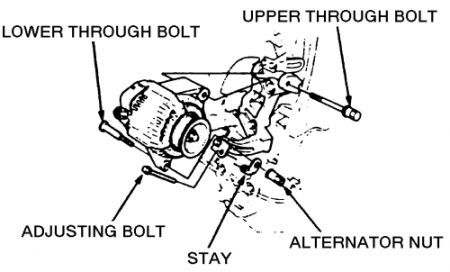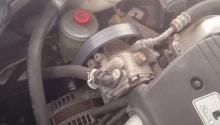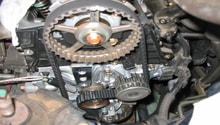Honda Accord: Why is My Alternator Belt Squeaking?
You start your car up, and it's whining louder than an unruly child. Your alternator belt may be shot. This article will help you pinpoint what is causing your Accord's alternator belt to squeak, and what you can do to repair it. So continue reading!
This article applies to the Honda Accord (1990-2002).
Many vehicles run several components of the motor through a system of belts and pulleys. All of those belts can wear over time, and should certainly be replaced per recommended maintenance intervals. Not replacing the belt can lead to serious damage to your motor. Often, the telltale sign that a belt is "going" is a noticeable screech or whining sound. It's caused by the friction of the belt against the pulley. More often, the belt is not tightened properly if it was recently replaced. In an off chance, it could be the groove on the pulley is dirty or rough, causing friction in a specific area as the belt spins.

Materials Needed
- Flat head screwdriver
- Assorted socket wrenches
- Open ended wrench
Step 1 – Remove the old belt
Whether the belt is the issue or not, it will still need to be removed to properly diagnose the squeal.
- Loosen the lower adjuster bolt to release tension on the belt.
- Remove the belt.

Pro Tip
Before removing the belt, you can check to see if the existing belt has any tension at all or is rather loose.
Step 2 – Visual inspection
With the belt removed and the pulley exposed, you can get a better look at what may be causing the squeal.
- Inspect the belt's underside for peeling or cracks.
- Inspect the pulley's outer grooves for glazing, dirt, and/or rough edges.

Figure 2. A worn belt. 
Figure 3. Belt inspection.
If the belt needs to be replaced, proceed to Step 3.
Step 3 – Install the new belt
If the visual inspection determines the belt is fine and the pulley is in good shape, best to replace the belt and ensure proper tension.
- Install the new belt.
- Tighten down adjustment bolt. See Figure 4 for the location.
- Ensure the new belt has no more than 8 to 10mm of deflection.

Related Discussions
- Replacing Alternator Belt - Honda-Tech.com
- Honda Serpentine Belt Replacement - Honda-Tech.com
- Belt Squeaking After Being Replaced - Honda-Tech.com






